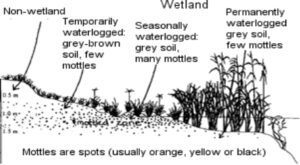WETLANDS
WETLANDS AND THE EIA PROCESS
Considering Wetlands In The EIA Process
What Is A Wetland?
- Wetlands are ecosystems or habitats for specific plants and animals that are saturated with water. The presence or absence of water determines their formation, processes and characteristics.
- Wetlands are characterised by specific vegetation, particular soils and the presence of water at least for a period of time in the year. A wetland may have all of these characteristics or only one or two of them.
- Floodplains, marshes, bogs, deltas, swamps, peatlands, estuaries, river catchments and lakes are all types of wetland.
- Wetlands occur in areas ranging from higher altitude mountain ranges (seeps), through to mid-catchment areas (marshes), through to estuaries at the coast.
- Some wetlands are constantly wet but others temporarily dry up.
- The type of wetland present depends on the soils, the rainfall, climate and the topography.
 Why Are Wetlands Important?
Why Are Wetlands Important?
- Water purification – wetlands are natural filters that trap pollutants.
- Reducing flooding – the vegetation in wetlands slows water down and helps reduce flooding.
- A wetland functions as a sponge and releases water throughout the year and recharges ground water supplies – stream flow regulation.
- The vegetation in wetlands reduces soil erosion.
- Biological diversity – wetlands provide habitat for a wide variety of species.
- Wetlands are some of the most biologically productive ecosystems in the world, by allowing nutrient recycling.
- Benefits for people – wetlands support a variety of fish and birds which can be a source of food; they also provide different types of reeds for building materials and handicrafts from which people can fulfill their basic needs and make a living.
- Agricultural use – livestock grazing.
- Recreational use – bird watching, aesthetics.
How Are Wetlands Affected By Developments?
Developments can affect the way a wetland functions. The type of development and the scale of the development will impact on the wetland, whether it is within the wetland or in the catchment area surrounding it. All the wetland functions mentioned above will be impacted on and could either be reduced or lost.
How Are Wetlands Harmed By Development?
- By the use of too much fertilizer. Fertilizer run-off from land causes algal blooms or rapid growth of algae in the water. Too much algae depletes all the oxygen in the water thereby killing the plants, fish and animals that live there.
- The incorrect application of non selective pesticides or herbicides that run into the wetlands degrades natural animal and plant populations and impacts on water quality.
- Direct destruction. Wetlands are often drained and permanently altered in order to accommodate building or the planting of crops.
- Direct degradation of wetland systems – damming for water storage, irrigation or recreation, draining through ridge and furrow technique for agricultural purposes.
- By direct disturbance – constant human activity in or close to the wetland.
- In a water-poor country such as South Africa, continued destruction of wetlands will result in :
- lower agricultural productivity;
- less pure water;
- less reliable water supplies;
- increased downstream flooding; and
- increasingly threatened plant and animal resources.
How To Consider Wetlands In The EIA Process?
Wetlands are classified as the most threatened ecosystem in the world.
In the EIA process, the following should be done:
- The wetland should be delineated or sketched in an outline.
- The biodiversity within the wetland should be assessed to determine its value.
- The impact of the development on the wetland (whether within the wetland or its catchment) – and its functions – should be assessed, and mitigation measures (actions to moderate) put in place to reduce these impacts.
- The cumulative impact on the broader catchment or the effects on the entire wetland environment should be taken into account.
- Wetlands must always be buffered with an appropriate area from any type of development which may impact on the wetland ecosystem.
- For more information on evaluating wetlands in the EIA process, visit the Mondi Wetlands Project and consult the wetlands delineation document.
Other Contacts
-
Working For Wetlands
Website: www.wetland.org.za
Postal Address
South African National Biodiversity Institute
Private Bag X101
Pretoria
0001
South AfricaTel: +27 12 843 5292
Fax: +27 12 843 5205